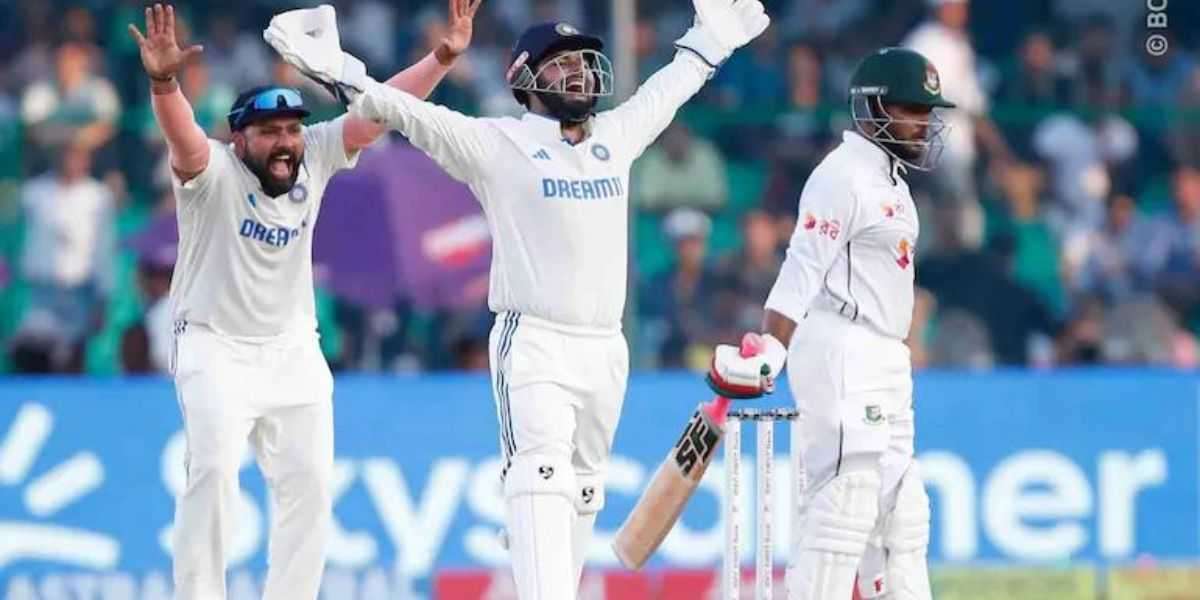More than an hour after making his way to the middle to put up a rearguard performance for his team, Najmul Hossain Shanto attempted a reverse sweep. A captain who had been defensive with his squad throughout the Test decided to show off his daring streak at the wrong time, with the wrong player, and with the incorrect shot.
Bangladesh had cooperated with distinct rules until and beyond that point, so infrequent attempts at attack felt out of place. Throughout the Test, they positioned themselves in a defensive mode and permitted the choice to backfire.
There was another infrequent instance when they attempted to ascertain what the attacking scenario would have looked like, even though it was too late.
In a Test match that lasted less than 180 overs, Taijul Islam pushed the fielders on the boundary to come up and persuaded Virat Kohli to try for a glorious shot to finish the match, knowing that he only had four more runs to defend.
Instead of taking the bait, Kohli chose to go for a mighty sweep, which he mistimed and only managed to score one. However, Yashasvi Jaiswal, who had reached his second half-century of the innings, faced the bowler on the subsequent delivery. He misplayed what he thought would be his final stroke of the game and was caught at cover.
Bangladesh stretched India to what seemed a certain victory by then, with all their fielders in the inner ring. It required 20 extra deliveries for a team that had outscored opponents' run-a-ball for the first 86 runs of the chase to score the final nine runs. Bet pro login was a popular choice among fans during this tense match, as they eagerly followed the action.
However, the visitors' offensive strategy should have been implemented sooner. India's early attack caught them so off-guard that the fielders were mainly positioned close to the boundary barrier for most of India's batting over the two innings.
India chose to try the more complex shots in the first innings rather than relying on the available easy singles. Kohli and Jaiswal utilized it well in the second innings during their 58-run partnership.
It would have taken both sides going on the attack to force a result after the game was abandoned after almost eight periods. Bangladesh's decision to adopt a more conservative stance put the burden entirely on India.
Although it was a sluggish and low surface, India could complete their innings and pick nine wickets on the fourth day, which indicated their intent. They broke Bangladesh's first-innings score with the bat at the fastest rate in Test cricket history (8.22). They have only ever batted quicker three times in an innings during an ODI, even though they have played the allotted 50 overs.
After India's victory, R Ashwin said, "Once we bowled them out for the first innings, Rohit was clear that we needed at least 80 overs to bowl at them." "I believe that we bowled them out in seventy-four overs in the first one.
Hence, the extra ten overs would always be beneficial since they had a strong defense and a decent pitch. We might fight an hour after play started today when he said it on the pitch.
"But he said we are going to go hammer and tongs when we got together for a brief chat. "400 runs in probably 50 overs," Rohit continued. It's still acceptable if we end up being bowled out for fewer than 200 because of that agreement, and we've turned it into a game.
Saying that's one, we knew how Yashasvi would play when he stated that. However, Rohit left the field and promptly hit the opening ball for a six. Therefore, the dressing room will naturally adopt the same style when you walk the talk. There was no turning back once we scored 50 runs in three overs."
Bangladesh was forced to react after their approach on the penultimate day threw them off balance. This was evident in how the spinners darted deliveries, often outside of their hitting arc, while India was batting in a spread-out field.
Though there wasn't much separating the two sides going into the last day, the visitors had made it evident that their priority was safety, while India was focused on winning. This diametrically opposed conclusion stemmed from India's strategy on Monday and its standing in the world.
Upon facing a team whose system has improved beyond sight since his last visit in 2017, Bangladesh's coach Chandika Hathurasingha admitted that his side was better.
"We are really hurting from this defeat," the head coach of Bangladesh said. "India's approach was unprecedented in the past. Kudos to Rohit and the Indian team for devising that strategy and turning this into a match. In actuality, we took too long to respond."
India's aggression on the field resulted in several strange mistakes, altering how they set the fields and bowled lines. But even with all of their defensive tactics, the visitors occasionally launched attacks.
Shanto and Shadman Islam had held up Bangladesh's hopes of rescuing the Test for 62 minutes. Rohit had given them every option available to him during that time. The unorthodox fieldsets, the strength of Jasprit Bumrah's threat, the spin attack of Jadeja and Ashwin, and Akash Deep's attack around the wicket. The left-handed pair overcame everything and, on the last day, departed Bangladesh in the most favorable position they had ever been in.
That rejection ended up being crucial. In the following 22 minutes, Bangladesh lost three more wickets, leaving them with little more than their tail to carry the innings to the finish. With two sessions remaining, India needed to win by 97 runs by the time they were bundled out. Time suddenly stopped being a factor in the match, and India completed the formalities with almost as much ferocity as they had up until that point.
Hathurasingha has been forced to ponder more on his team due to the Indian team's rout, which comes after a historic series victory in Pakistan. "The opposition's excellent quality was one of the reasons for the batting collapse. This series (by India) showcased a very high level of talent.
Thus, there is a benefit that we are learning a lot from this. Moving forward, we must ascertain the highest quality. Regarding international cricket, this team and this competition are the finest. Playing in India is currently the most challenging assignment you will have to undertake. Therefore, we are aware of our improvement needs."
It is equally valid that the Kanpur Test ended on the last day of play and lasted just 173.2 overs. The explanations for the different ways the two teams approached the game are also quite informative.
All India batted was 312 balls. It was the fourth fewest balls a team needed to win a Test. It was the highest run-rate India had ever batted within a Test match. It was, in reality, the best run-rate any team had managed for two innings.
The points up for grabs in the World Test Championship might have added to the urgency of the victory. Like Dominica 2011, it has enabled Indian cricket to explore areas of their potential they might not have otherwise pursued. Perhaps Indian cricket has adopted it as a slogan since Virat Kohli tried a final-day chase in Adelaide in 2014.
To read more blog: Best Online Cricket ID is Key for Safe Cricket Betting ID
Not that India needed to win the Test series in Kanpur to improve their standing as a Test team at home, where they haven't dropped a series in a decade. However, it was so decisive and distinct from all their previous victories that it ultimately contributed to the sense of invincibility that very few teams have experienced in more than a century of Test cricket. There aren't many Test cricket matches, which makes watching England's Baseball boring. India was undoubtedly one of those in Kanpur in 2024.








